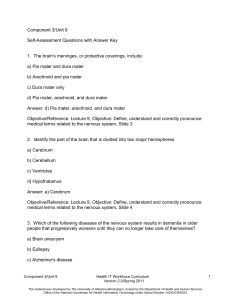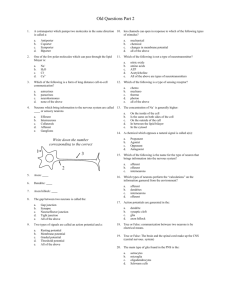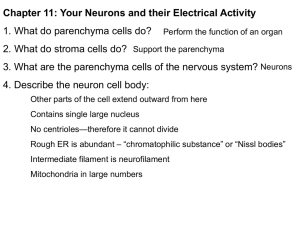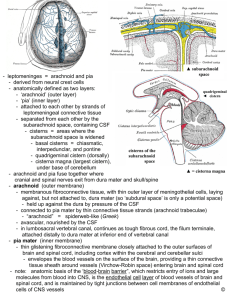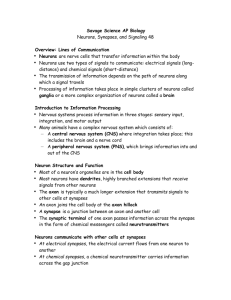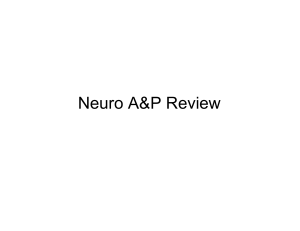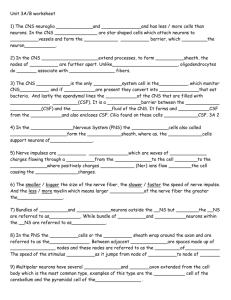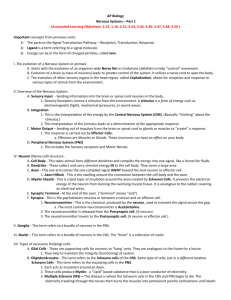Biopsychology (Psy 308) – Sample Exam 1 Dr. Alcantara 1. The first
advertisement
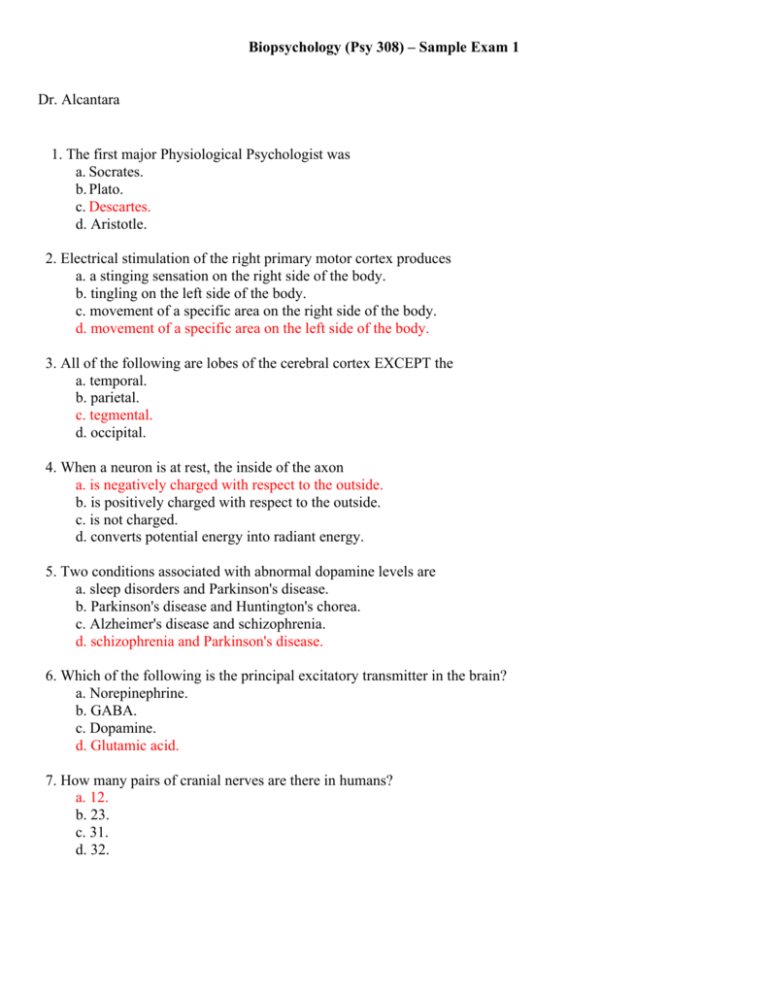
Biopsychology (Psy 308) – Sample Exam 1 Dr. Alcantara 1. The first major Physiological Psychologist was a. Socrates. b. Plato. c. Descartes. d. Aristotle. 2. Electrical stimulation of the right primary motor cortex produces a. a stinging sensation on the right side of the body. b. tingling on the left side of the body. c. movement of a specific area on the right side of the body. d. movement of a specific area on the left side of the body. 3. All of the following are lobes of the cerebral cortex EXCEPT the a. temporal. b. parietal. c. tegmental. d. occipital. 4. When a neuron is at rest, the inside of the axon a. is negatively charged with respect to the outside. b. is positively charged with respect to the outside. c. is not charged. d. converts potential energy into radiant energy. 5. Two conditions associated with abnormal dopamine levels are a. sleep disorders and Parkinson's disease. b. Parkinson's disease and Huntington's chorea. c. Alzheimer's disease and schizophrenia. d. schizophrenia and Parkinson's disease. 6. Which of the following is the principal excitatory transmitter in the brain? a. Norepinephrine. b. GABA. c. Dopamine. d. Glutamic acid. 7. How many pairs of cranial nerves are there in humans? a. 12. b. 23. c. 31. d. 32. 8. A node of Ranvier is a a. bundle of microtubules. b. naked portion of a myelinated axon. c. group of neural cell bodies in the central nervous system. d. knob-like structure at the end of an axon. 9. In mammals, the superior colliculi are involved in a. auditory output. b. regulating the autonomic nervous system. c. hindbrain function. d. vision. 10. The term "cortex" is the name given to the a. outer surface of the brain. b. grooves on the outer surface of the brain. c. white matter of the brain. d. "primitive" area of the brain. 11. Darwin revolutionized biology by formulating the principle of a. natural selection. b. inherited consolidation. c. genotypical selection. d. natural concordance. 12. Cocaine can be highly addictive because it a. increases alertness. b. increases activity of dopaminergic neurons involved in reinforcement. c. produces euphoria. d. releases endogenous opiates. 13. The structure that is cut during the split-brain operation is the a. cingulate gyrus. b. lateral fissure. c. corpus callosum. d. posterior commissure. 14. Autoreceptors regulate neurotransmitter release primarily by a controlling ion channels. b. producing changes in the membrane potential. c. regulating the synthesis and release of the neurotransmitter. d. all of the above. 15. A bulge or convolution of the cerebral cortex is called a a. fissure. b. sulcus. c. ganglion. d. gyrus. 16. A decrease in the effectiveness of a drug that is administered repeatedly is called a. tolerance. b. sensitization. c. addictiveness. d. the therapeutic index. 17. The sites of protein synthesis are called a. granules. b. ribosomes. c. lysosomes. d. genes. 18. Another word for rostral is a. posterior. b. superior. c. anterior. d. inferior. 19. When an odor enters the right nostril, a split-brain patient would be able to a. say what produced the odor. b. use the left hand to select objects related to the odor. c. use the right hand to select objects related to the odor. d. use the right hemisphere to speak. 20. The strength or intensity of a neuronal signal (e.g. a pain signal or visual signal) is determined by a. The size of the action potential. b. The rate of firing of a neuron. c. The type of receptor that is activated. d. The type of neuron that is activated. 21. What happens to an axon when a positive charge is applied to the inside of its membrane? a. Hyperpolarization. b. No change. c. Depolarization. d. An action potential. 22. The hereditary disorder called myasthenia gravis is caused by an attack of one's immune system against _________ receptors. a. acetylcholine. b. dopamine. c. serotonin. d. glycine. 23. Which of the following is NOT given as a role for serotonin? a. Control of eating. b. Visual perception. c. Sleep. d. Regulation of pain. 24. Dopamine produces EPSPs or IPSPs depending on the a. ion channels controlled by postsynaptic receptors. b. amount of neurotransmitter that is released. c. presence of neuromodulators. d. concentration of choline in presynaptic neurons. 25. Nuclei that control vital functions such as respiration are located in the a. medulla. b. thalamus. c. cerebellum. d. pons. 26. Which of the following indicates the proper order of neural transmission in a neuron? a. Axon, cell body, dendrite, dendritic spine. b. Terminal button, axon, cell body, dendrite. c. Cell body, dendritic spine, terminal button, axon. d. Dendrite, cell body, axon, terminal button. 27. The division of the nervous system that contains neurons which control heart and smooth muscles is the ____________ nervous system. a. central. b. peripheral. c. autonomic. d. somatic. 28. Acetylcholine plays a role in a. REM sleep. b. learning and memory. c. activation of the autonomic nervous system. d. All of the above. 29. Which of the following statements about CSF is NOT true? a. CSF is produced by the choroid plexus. b. The total volume of CSF is replaced twice weekly. c. CSF cushions the brain and spinal cord. d. The subarachnoid space is filled with CSF. 30. The hypothalamus plays a role in a. fighting. b. eating. c. mating. d. All of the above. 31. The part of a cell that contains the nucleus is called the a. axon. b. soma. c. dendrite. d. mitochondrion. 32. All of the following are characteristics of NMDA receptors EXCEPT a. they are metabotropic. b. they control calcium channels. c. they are important in development and learning. d. they are a type of glutamate receptor. 33. The complex, diffuse network of nuclei and neural pathways located in the core of the brain stem is called the a. periaqueductal gray. b. cerebellum. c. reticular formation. d. medulla oblongata. 34. All of the following are found in the cell nucleus EXCEPT a. chromosomes. b. deoxyribonucleic acid. c. genes. d. sites for protein synthesis. 35. The cells that produce myelin in the peripheral nervous system are called a. phagocytes. b. astrocytes. c. oligodendrocytes. d. Schwann cells. 36. Phagocytes are specialized cells that a. clean up neuronal debris. b. regulate chemicals in the fluid surrounding neurons. c. manufacture a protective neuronal sheath. d. provide physical support to neurons. 37. The condition called unilateral neglect is caused by damage to the a. left parietal lobe. b. right parietal lobe. c. left temporal lobe. d. right temporal lobe. 38. Noradrenergic neurons in the brain control a. drinking and eating. b. sexual behavior. c. the autonomic nervous system. d. wakefulness. 39. Mutations occur from a. accidental changes in chromosomes. b. poor adaptation to the environment. c. adverse transformations after birth. d. deficient conditions during gestation. 40. The cerebral cortex receives most of its input from the a. limbic system. b. basal ganglia. c. thalamus. d. medulla oblongata. 41. The function of mitochondria is to a. transport substances. b. provide energy. c. package enzymes. d. assemble proteins. 42. Which of the following sequences correctly depicts the order in which the brain is covered (from the brain outward toward the skull)? a. Dura mater, pia mater, arachnoid. b. Arachnoid, dura mater, pia mater. c. Pia mater, arachnoid, dura mater. d. Dura mater, arachnoid, pia mater. 43. One function of the specialized protein molecules in a membrane is to a. selectively allow substances to enter or leave the cell. b. provide oxygen and nutrients for the cell. c. package neurotransmitters. d. form an impermeable barrier to all substances foreign to the cell. 44. The basal ganglia are a. part of the limbic system. b. subcortical nuclei located in the forebrain. c. located in the brain stem. d. nuclei that send sensory information to the cortex. 45. A neurotransmitter may open an ion channel directly by attaching to a (an) a. metabotropic receptor. b. G protein. c. ionotropic receptor. d. second messenger. 46. The enzyme that accepts an acetate ion from coenzyme A and transfers it to a choline molecule, producing acetylcholine, is called a. acetylcholinesterase. b. coenzyme A. c. choline acetyltransferase. d. acetate cholinaltransferase. 47. Which structure is part of the limbic system? a. Basal ganglia. b. Tectum. c. Tegmentum. d. Hippocampus. 48. Alzheimer’s Disease involves damage to the cholinergic neurons located in the a. Raphe nucleus. b. Locus coeruleus. c. Striatum. d. Basal forebrain. 49. The activation of second messenger cascades may give rise to a. The synthesis of new proteins. b. Structural changes in the brain. c. Learning and memory processes. d. All of the above. 50. The major types of neurons in the cerebral cortex are a. Purkinje cells. b. Glial cells. c. Pyramidal cells. d. Unipolar neurons.
